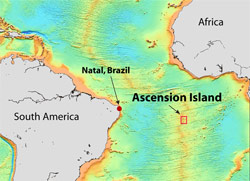|
Our Mission: January 1 - 17, 2008 For years, ocean scientists have dreamt about sending small fleets of underwater robots to explore the ocean depths. But the ocean presents formidable obstacles to navigating and communicating with robots in the deep. On New Year’s Eve, an expedition gets under way to try cutting-edge technology to overcome those barriers. If successful, the research cruise could herald a revolution in the way scientists explore the deep sea. On an 18-day expedition to the South Atlantic Ocean aboard the research vessel Knorr, researchers will try something they’ve never done before. They will unleash two deep-sea robots, called Puma and Jaguar, at the same time. The two are Autonomous Underwater Vehicles (AUVs), which means they swim freely—unpiloted and unattached via a cable to the ship. As the underwater “cats” roam miles below, scientists and engineers will test navigation and communication technologies that will enable the AUVs to “talk” to each other and to scientists aboard Knorr in real time. The robotic dynamic duo will prowl a little-explored stretch of the Mid-Atlantic Ridge No radio down below And, it turns out the ocean is a noisy place. Any noise from other sound sources, whether natural (whales, or submarine landslides, for example) or human-made (the AUV’s own thrusters), can interfere with communications. Having two vehicles operating in the same area at the same time further complicates the challenge. On this mission, researchers will test new acoustic (sound) networks to try to overcome these problems, conducting a sort of “three-way call” between Puma, Jaguar and the ship. Underwater vehicles also use sound to navigate. Ocean scientists set out a “box” of sound transmitters and receivers on the seafloor in which the AUVs operate. By listening in on the signals being sent back and forth between AUVs and these transmitter/receivers, scientists can figure out where the vehicles are within the box. But the box limits how far and wide AUVs can roam, and, once again, having more than one vehicle operating in the box increases the risks of crisscrossing signals and interference. To try to solve this problem, scientists will try a novel communication and navigation system. Advancing the limits of technology This expedition will take the first step toward accomplishing that vision. We set sail from Natal, Brazil, on a five-and-a-half-day transit to our target location: a segment of the ocean ridge 2,500 meters (about 1.5 miles) beneath the surface of the Atlantic Ocean between 2˚ and 8˚ South latitude Will this novel tag-team AUV approach work? We will be writing a new blueprint for operating two deep-sea robots simultaneously—pushing the envelope of technology to push the envelope of exploration.
|
Mailing List | Feedback | Glossary | For Teachers | About Us | Contact
© 2010 Dive and Discover™. Dive and Discover™ is a registered trademark of Woods
Hole Oceanographic Institution

